- Home
- The Autumn Garden
- Autumn Flowers for Trees and Shrubs
Autumn Flowers: Trees and Shrubs
That Bloom in the Fall
Trees and shrubs with autumn flowers are to be treasured for their non-conformist habit of blooming late in the year, and all the more so because there are so few of them. When memories of spring's glories are long gone, along come these rebels with welcome surprise and color--some right along with lovely shades of autumn leaves as well.
Abelia x grandiflora, glossy abelia, Zones 6-9. Here is a flowering shrub that doesn’t know when to quit blooming. It goes non-stop from late spring until stopped by frost in many areas. Small white or pink tubular flowers occur in clusters on slender arching branches, Bees, butterflies, and other pollinators adore it. Semi-evergreen in the South, and is often the first shrub to start leafing out in spring. A fast grower, abelia benefits from a severe cutback every few years. New cultivars have been developed for compactness and interesting variegated foliage colors. Some to look for include ‘Kaleidoscope,’ ‘Miss Lemon™,’ ‘Mardi Gras,’ and Suntastic™ ‘Radiance.’’
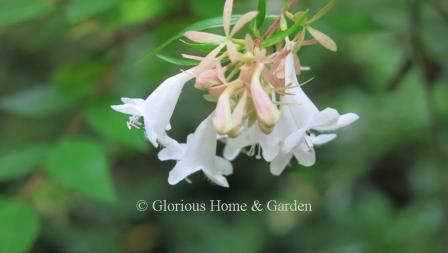 Abelia x grandiflora
Abelia x grandiflora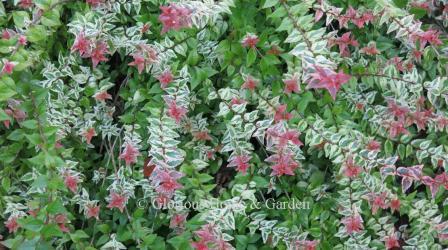 Abelia x grandiflora 'Mardi Gras'
Abelia x grandiflora 'Mardi Gras'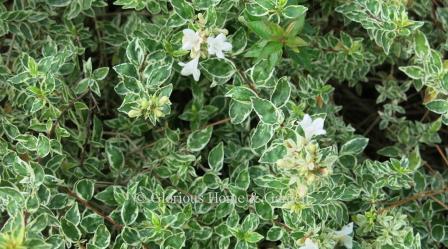 Abelia x grandiflora 'Radiance'
Abelia x grandiflora 'Radiance'Arbutus unedo, strawberry tree, Zones 7-9. This evergreen shrub produces small, white blueberry-like autumn flowers and the strawberry-like fruit appears the following year.
 Arbutus unedo
Arbutus unedoCamellias for Autumn Flowers
Camellia sasanqua, sasanqua camellia, Zones 7-9. Camellia sasanquas are the most beloved of fall blooming shrubs.'Yuletide' shown below.' Click here to see some favorite varieties.
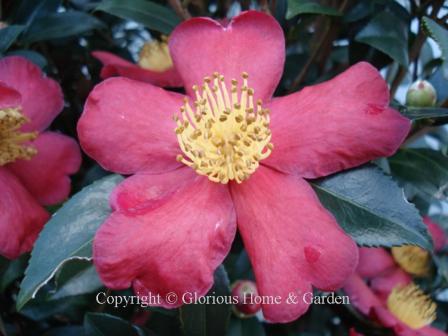 Camellia sasanqua 'Yuletide'
Camellia sasanqua 'Yuletide'Camellia sinensis, tea plant, Zones 6-9. This fall blooming shrub is the plant from which tea is made and it also makes a superb garden plant. The small white flowers occur throughout the fall.
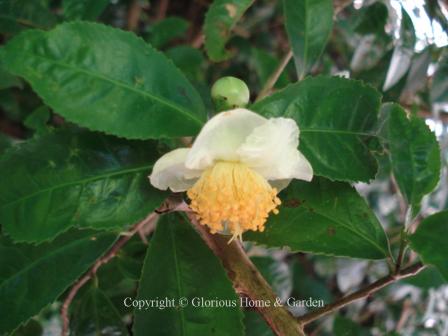 Camellia sinensis
Camellia sinensisFatsia japonica, Japanese fatsia or aralia, Zones 8-10. 1-1 1/2" white globular flower umbels form a large collective panicle in the center of the palmate leaves in mid-to late fall, followed by small black fruits. Prefers shade.
 Fatsia japonica in bloom
Fatsia japonica in bloomHamamelis virginiana, witch hazel, Zones 3-8. Fragrant yellow long-petaled flowers often occur at the same time as the leaves turn a clear yellow in the fall. One of our best native shrubs.
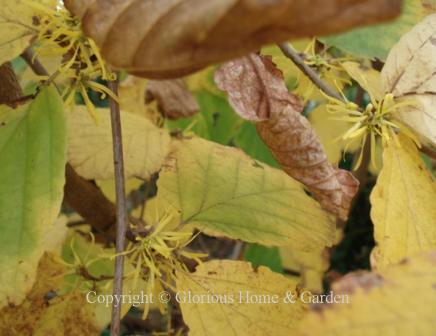 Hamamelis virginiana
Hamamelis virginianaJasminium officinale, common white jasmine, Zones 8-10. The fragrant white flowers appear through October and are prized in the warmer parts of the country.
Mahonia eurybracteata ‘Soft Caress,’ Zones 7-9. Love the bright yellow flowers of mahonia, but are wary of the prickly holly-like leaves? Then you will fall in love with ‘Soft Caress’ which has the brilliant yellow flowers, but skin-friendly, fern-like evergreen leaves with no prickles. And it blooms in late fall into early winter when not much else is happening in the garden. In fact, mine began blooming in late October in my 8a Georgia garden. Another delight is its smaller size—about 3 ½’ x 3 ½’—which tucks handily into many places like foundation plantings, mass groupings, edgings, even containers, while Mahonia bealei, for instance, can reach 6-12 ft. ‘Soft Caress’ grows well in partial sun to shade, but will bloom more freely with more sun—but do protect it from strong afternoon sun. Grow in well-drained soil rich in organic matter, and a little on the alkaline side of the pH spectrum. Adding lime, wood ash, bone meal, or even crushed eggshells can help to raise the pH level if you are in a mainly acidic soil area. Also known as Berberis eurybracteata ‘Soft Caress.’
 Mahonia eurybracteata 'Soft Caress'
Mahonia eurybracteata 'Soft Caress'Osmanthus for Autumn Flowers
and Sweet Fragrance
Osmanthus fragrans, fragrant tea olive, Zones 7-10. If I only had one fall-blooming shrub, this would be it! The sweet, delicious scent from the tiny white flowers September into March is intoxicating, but never over-powering. The one pictured below is called 'Fudingzhu,' which is especially heavy-blooming, and there are several others including an orange-flowered one called 'Orange Supreme.' Osmanthus f. var. aurantiacus is another good orange one--see below. Outstanding fragrance. A beautiful variegated form is 'Yinbi Shuanghui' which has green and cream foliage with pink new growth and blooms in fall and intermittently through spring.
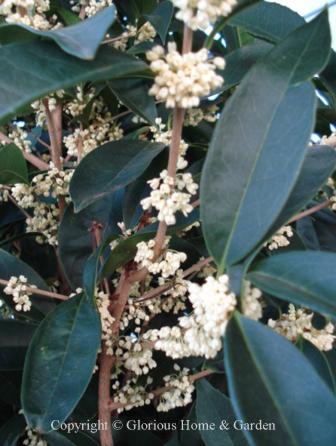 Osmanthus fragrans 'Fudingzhu'
Osmanthus fragrans 'Fudingzhu'Osmanthus fragrans var. aurantiacus, orange tea olive, Zones 7-10. this osmanthus has the benefit of orange autumn flowers that are perfect with fall hues--and, of course, great fragrance! However, it only blooms in fall.
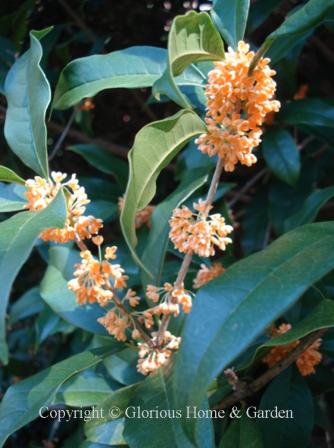 Osmanthus fragrans var. aurantiacus
Osmanthus fragrans var. aurantiacusOsmanthus fragrans 'Apricot Echo,' Zones 7-10. This cultivar of osmanthus has soft apricot flowers and has the advantage of repeat blooming, unlike O. fragrans var. aurantiacus.
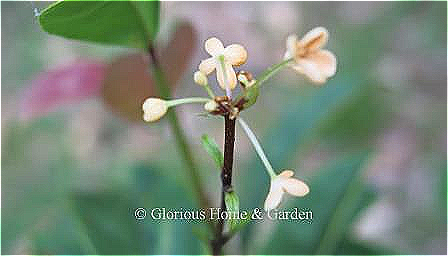 Osmanthus fragrans 'Apricot Echo'
Osmanthus fragrans 'Apricot Echo'Osmanthus fragrans 'Yinbi Shuanghui, variegated tea olive, Zones 7-10. An outstanding ornamental tea olive with variegated foliage of cream, green and pink. Fragrant white flowers appear in fall and repeat into spring.
 Osmanthus fragrans 'Yinbi Schuanghui'
Osmanthus fragrans 'Yinbi Schuanghui'Osmanthus heterophyllus, holly osmanthus, Zones 6-9. Highly fragrant white flowers, and hardier than O. fragrans. Most cultivars have spiny leaves resembling holly.
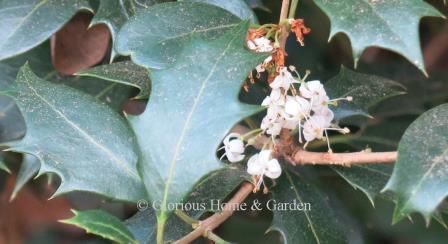 Osmanthus heterophyllus "Gulftide'
Osmanthus heterophyllus "Gulftide'Potentilla fruticosa, bush cinquefoil, Zones 2-6. Small shrub that flowers summer until frost primarily in yellow, but also pink and orange-red. Best in the North.
Roses for Autumn Flowers
Many hybrid tea roses and others such as the Drift® roses, and Knock Out® roses are good sources for autumn flowers as they will bloom until frost.
I like the David Austin English roses also for their habit of waves of blooms from spring until stopped by the cold. 'Graham Thomas,' named for the famous rosarian, has beautiful golden blooms with a hint of apricot and often there will be buds left on the plant that did not have a chance to open. 'Anne Boleyn,' named for King Henry VIII's 2nd wife (looks like she's hanging her head for the executioner), was blooming in November (in Georgia.
 Rosa 'Anne Boleyn'
Rosa 'Anne Boleyn' Rosa 'Graham Thomas'
Rosa 'Graham Thomas'Rosa chinensis 'Mutabilis,' butterfly rose. Zones 7-8. This rose is fascinating in that the five-petaled single flowers change color as they mature. Opening yellow, each flower goes through several “mutations” from peach to pink to deep rose-pink. So, when in full bloom all the colors can be present simultaneously. And as it blooms from late spring right up ‘til frost, the show lasts a long time.
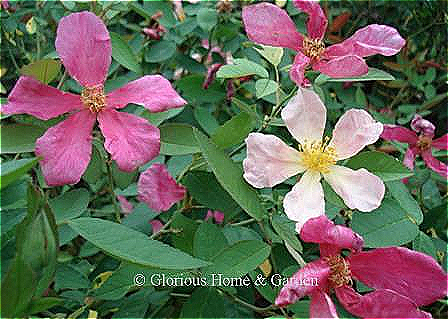 Rosa chinensis 'Mutabilis
Rosa chinensis 'MutabilisRosa rugosa, beach rose, Zones 2-7. Deep pink fragrant single flowers bloom heavily in summer and continue intermittently until frost. The flowers are followed by large, red hips which make a delicious jelly. A tough plant, Rosa rugosa is a common sight on the seashore, where it can tolerate salt-spray and strong wind. The is a white one, 'Alba,' and also other cultivars. See Species Roses.
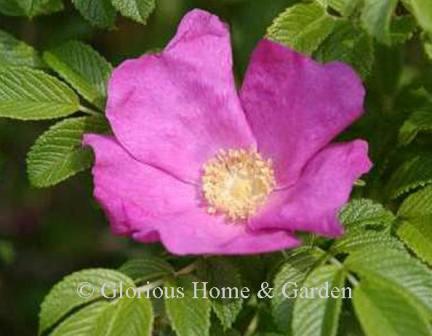 Rosa rugosa
Rosa rugosa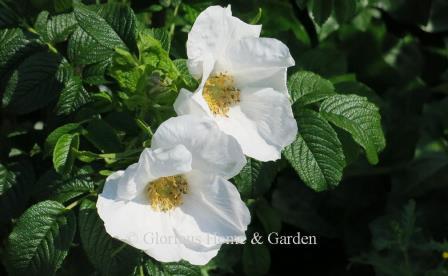 Rosa rugosa 'Alba'
Rosa rugosa 'Alba'Plant of the Month
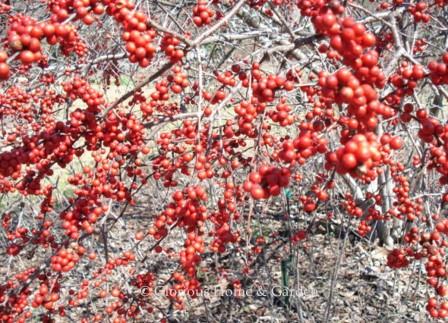
Ilex verticillata
Winterberry holly
Updated new USDA Plant Hardiness Zone Map 2023.